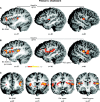Investigating emotion with music: an fMRI study
- PMID: 16078183
- PMCID: PMC6871371
- DOI: 10.1002/hbm.20180
Investigating emotion with music: an fMRI study
Abstract
The present study used pleasant and unpleasant music to evoke emotion and functional magnetic resonance imaging (fMRI) to determine neural correlates of emotion processing. Unpleasant (permanently dissonant) music contrasted with pleasant (consonant) music showed activations of amygdala, hippocampus, parahippocampal gyrus, and temporal poles. These structures have previously been implicated in the emotional processing of stimuli with (negative) emotional valence; the present data show that a cerebral network comprising these structures can be activated during the perception of auditory (musical) information. Pleasant (contrasted to unpleasant) music showed activations of the inferior frontal gyrus (IFG, inferior Brodmann's area (BA) 44, BA 45, and BA 46), the anterior superior insula, the ventral striatum, Heschl's gyrus, and the Rolandic operculum. IFG activations appear to reflect processes of music-syntactic analysis and working memory operations. Activations of Rolandic opercular areas possibly reflect the activation of mirror-function mechanisms during the perception of the pleasant tunes. Rolandic operculum, anterior superior insula, and ventral striatum may form a motor-related circuitry that serves the formation of (premotor) representations for vocal sound production during the perception of pleasant auditory information. In all of the mentioned structures, except the hippocampus, activations increased over time during the presentation of the musical stimuli, indicating that the effects of emotion processing have temporal dynamics; the temporal dynamics of emotion have so far mainly been neglected in the functional imaging literature.
Copyright 2005 Wiley-Liss, Inc.
Figures



References
-
- Ackermann H, Riecker A (2004): The contribution of the insula to motor aspects of speech production: a review and a hypothesis. Brain Lang 89: 320–328. - PubMed
-
- Adolphs R, Tranel D, Damasio H, Damasio A (1994): Impaired recognition of emotion in facial expressions following bilateral damage to the human amygdala. Nature 372: 669–672. - PubMed
-
- Adolphs R, Tranel D, Damasio A (1998): The human amygdala in social judgement. Nature 393: 470–474. - PubMed
-
- Amaral D, Price J (1984): Amygdalo‐cortical projections in the monkey (Macaca fascicularis). J Comp Neurol 230: 465–496. - PubMed
-
- Anderson AK, Phelps EA (1998): Intact recognition of vocal expressions of fear following bilateral lesions of the human amygdala. Neuroreport 9: 3607–3613. - PubMed
Publication types
MeSH terms
LinkOut - more resources
Full Text Sources
Other Literature Sources

